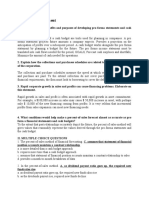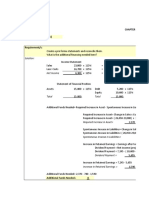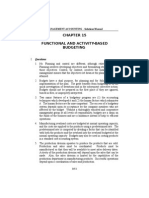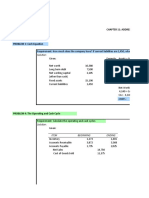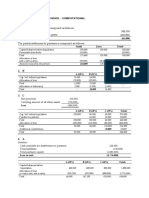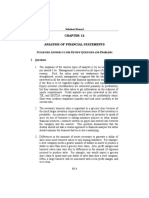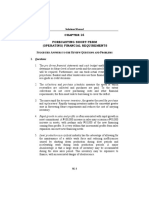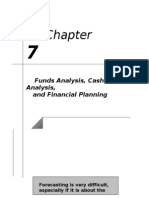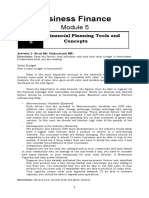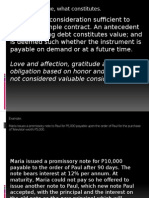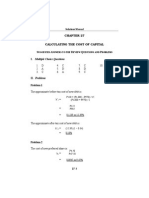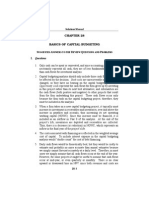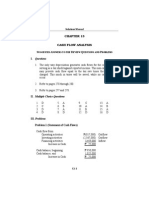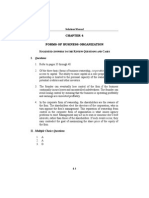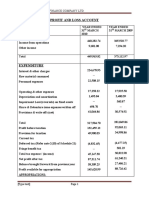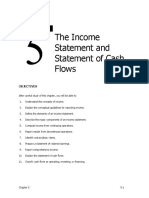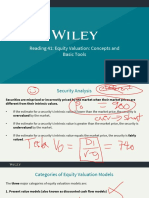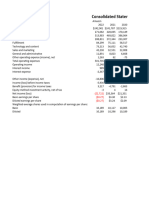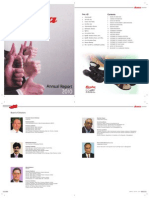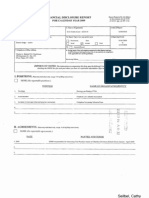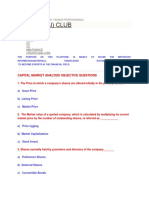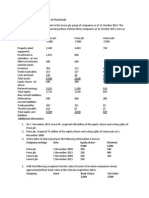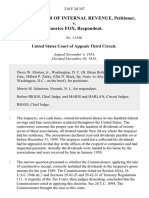Solutions Manual
CHAPTER 16
FORECASTING SHORT-TERM
(OPERATING) FINANCIAL REQUIREMENTS
SUGGESTED ANSWERS TO THE REVIEW QUESTIONS AND PROBLEMS
I. Questions
1. The pro forma financial statements and cash budget enable the firm to
determine its future level of asset needs and the associated financing that
will be required. Furthermore, one can track actual events against the
projections. Bankers and other lenders also use these financial statements
as a guide in credit decisions.
2. The collections and purchase schedules measure the speed at which
receivables are collected and purchases are paid. To the extent collections
do not cover purchasing costs and other financial requirements, the firm
must look to borrowing to cover the deficit.
3. The more rapid the turnover inventory, the greater the need for purchase
and replacement. Rapidly turning inventory makes for somewhat greater
ease in foreseeing future requirements and reduces the cost of carrying
inventory.
4. Rapid growth in sales and profits is often associated with rapid growth in
asset commitment. A 100,000 increase in sales may occasion a 50,000
increase in assets, with perhaps only 10,000 of the new financing
coming from profits. It is very seldom that incremental profits from sales
expansion can meet new financing needs.
5. Level production in a cyclical industry has the advantage of allowing for
the maintenance of a stable work force and reducing inefficiencies
caused by shutting down production during slow periods and
accelerating work during crash production periods. A major
disadvantage is that a large stock of inventory may be accumulated
during the slow sales period. This inventory may be expensive to
finance, with an associated danger of obsolescence.
16-1
�Chapter 16
Forecasting Short-term (Operating) Financial Requirements
6. The percent-of-sales forecast is only as good as the functional
relationship of assets and liabilities to sales. To the extent that past
relationships accurately depict the future, the percent-of-sales method
will give values that reasonably represent the values derived through the
pro forma statements and the cash budget.
7.
a. Sales forecast a forecast of a firms unit and peso sales for some
future period; generally based on recent sales trends plus forecasts of
the economic prospects for the nation, region, industry and so forth.
b. Projected financial statement method a method of forecasting
financial requirements based on forecasted financial statements.
c. Spontaneously generated funds funds that are obtained
automatically from routine business transactions.
d. Dividend payout ratio the percentage of earnings paid out in
dividends.
e. Pro forma financial statement same as letter (b)
f.
Additional funds needed (AFN) funds that a firm must raise
externally through borrowing or by selling new common or preferred
stock.
AFN formula = Required increase in assets Spontaneous increase
in liabilities Increase in retained earnings
g. Capital intensity ratio the amount of assets required per peso of
sales (A/S).
h. Lumpy assets assets that cannot be acquired in small increments
but must be obtained in large, discrete units.
i.
Financing feedback the effects on the income statement and
balance sheet of actions taken to finance increases in assets.
8. A budget is a detailed quantitative plan for the acquisition and use of
financial and other resources over a given time period. Budgetary control
involves using budgets to increase the likelihood that all parts of an
organization are working together to achieve the goals set down in the
planning stage.
16-2
�Forecasting Short-term (Operating) Financial Requirements
Chapter 16
9. a. Budgets communicate managements plans throughout the
organization.
b. Budgets force managers to think about and plan for the future. In the
absence of the necessity to prepare a budget, many managers would
spend all of their time dealing with day-to-day emergencies.
c. The budgeting process provides a means of allocating resources to
those parts of the organization where they can be used most
effectively.
d. The budgeting process can uncover potential bottlenecks before they
occur.
e. Budgets coordinate the activities of the entire organization by
integrating the plans of its various parts. Budgeting helps to ensure
that everyone in the organization is pulling in the same direction.
f.
Budgets define goals and objectives that can serve as benchmarks for
evaluating subsequent performance.
10. A master budget represents a summary of all of managements plans and
goals for the future, and outlines the way in which these plans are to be
accomplished. The master budget is composed of a number of smaller,
specific budgets encompassing sales, production, raw materials, direct
labor, manufacturing overhead, selling and administrative expenses, and
inventories. The master budget usually also contains a budgeted income
statement, budgeted balance sheet, and cash budget.
11. The level of sales impacts virtually every other aspect of the firms
activities. It determines the production budget, cash collections, cash
disbursements, and selling and administrative budget that in turn
determine the cash budget and budgeted income statement and balance
sheet.
12. No. Planning and control are different, although related concepts.
Planning involves developing goals and developing budgets to achieve
those goals. Control, by contrast, involves the means by which
management attempts to ensure that the goals set down at the planning
stage are attained.
16-3
�Chapter 16
Forecasting Short-term (Operating) Financial Requirements
13. The flow of budgeting information moves in two directionsupward
and downward. The initial flow should be from the bottom of the
organization upward. Each person having responsibility over revenues or
costs should prepare the budget data against which his or her subsequent
performance will be measured. As the budget data are communicated
upward, higher-level managers should review the budgets for consistency
with the overall goals of the organization and the plans of other units in
the organization. Any issues should be resolved in discussions between
the individuals who prepared the budgets and their managers. All levels
of an organization should participate in the budgeting processnot just
top management or the accounting department. Generally, the lower
levels will be more familiar with detailed, day-to-day operating data, and
for this reason will have primary responsibility for developing the
specifics in the budget. Top levels of management should have a better
perspective concerning the companys strategy.
14. The direct labor budget and other budgets can be used to forecast
workforce staffing needs. Careful planning can help a company avoid
erratic hiring and laying off of employees.
15. The principal purpose of the cash budget is NOT to see how much cash
the company will have in the bank at the end of the year. Although this is
one of the purposes of the cash budget, the principal purpose is to
provide information on probable cash needs during the budget period, so
that bank loans and other sources of financing can be anticipated and
arranged well in advance.
II. Multiple Choice Questions
1.
2.
3.
4.
5.
B
B
E
C
C
6.
7.
8.
9.
10.
D
C
C
C
D
11.
12.
13.
14.
15.
A
C
C
C
D
16-4
16.
17.
18.
19.
20.
C
B
C
B
C
21.
22.
23.
24.
25.
C
A
B
C
A
�Forecasting Short-term (Operating) Financial Requirements
Chapter 16
III. Problems
Problem 1
a.
Sales
Credit sales
Collections:
Cash
(10% of Sales)
60% first month
after sale
40% second
month after sale
Total Receipts
Februar
y
60,000
March
April
May
June
75,000
67,500
95,00
0
85,500
110,000
54,000
70,00
0
63,000
6,000
7,000
7,500
9,500
11,000
37,800
40,500
51,300
21,600
66,900
25,200
75,20
0
27,000
89,300
b. Receivables at End of June:
90% of June Sales
40% of May Credit Sales
99,000
99,000
34,200
133,200
Problem 2
January
Cash
4,200
Credit
9,800
Collections:
Cash
40% on the following month
60% on the second month
Total Collections
Collections
Payments
Cash Flow
February
6,000
11,400
March
7,800
18,200
April
6,600
15,400
7,800
5,600
5,880
19,280
6,600
7,280
8,400
22,280
5,400
6,160
10,920
22,48
0
Cash Budget
19,280 22,280
21,300
(2,020)
16-5
19,100
3,180
22,48
0
22,400
80
May
5,400
12,600
�Chapter 16
Forecasting Short-term (Operating) Financial Requirements
+ Beginning Cash Balance
Cumulative Cash Balance
Loan (Repayment)
Cumulative Loan Balance
Ending Cash Balance
Problem 3
a.
Sales
Credit sales
Collections:
Cash
(10% of Sales)
70% 1 month
following sale
30% 2 months
following sale
Monthly Cash
Receipts
2,000
(20)
2,020
4,020
2,000
2,000
5,180
(3,180)
840
2,000
2,000
2,080
(80)
760
2,000
February
60,000
March
80,000
72,000
May
120,00
0
108,000
June
110,000
54,000
April
100,00
0
90,000
10,000
12,000
11,000
50,400
63,000
75,600
16,200
21,600
27,000
76,600
96,600
113,600
b. Accounts receivables at the End of June:
90% of June Credit Sales
30% of May Credit Sales
Total Receivables Balance
99,000
99,000
32,400
131,400
Problem 4
a.
February sales:
230,000 10%
March sales:
260,000 70%, 10%
April sales: 300,000
20%, 70%, 10%
May sales:
500,000 20%, 70%
June sales:
200,000 20%
April
May
June
23,000
Total
23,000
182,000
26,000
60,000
210,000
30,000
300,000
100,000
350,000
450,000
40,000
40,000
16-6
208,000
�Forecasting Short-term (Operating) Financial Requirements
Total cash collections
265,000
336,000 420,000
Chapter 16
1,021,000
Observe that even though sales peak in May, cash collections peak in June.
This occurs because the bulk of the companys customers pay in the month
following sale. The lag in collections that this creates is even more
pronounced in some companies. Indeed, it is not unusual for a company to
have the least cash available in the months when sales are greatest.
b. Accounts receivable at June 30:
From May sales: 500,000 10%
From June sales: 200,000 (70% + 10%)
Total accounts receivable at June 30
50,000
160,000
210,000
Problem 5
(3,000 x 1.20)
(200 x 1.10)
Unit volume
Price
Total sales
Returns (5%)
Net sales
3,600
220
792,000
39,600
752,400
Problem 6
Projected sales
Desired ending inventory
Beginning inventory
Units to be produced
40,000 units
6,000 (15% x 40,000)
8,500
37,500
Problem 7
12,000 units (8,000 x 1.50)
600 (5% x 12,000)
400
12,200
Projected sales
Desired ending inventory
Beginning inventory
Units to be produced
16-7
�Chapter 16
Forecasting Short-term (Operating) Financial Requirements
Problem 8
Projected sales
Desired ending inventory
Beginning inventory
Units to be produced
50,000 units
5,600 (40% x 14,000)
14,000
41,600
Problem 9
Credit sales
20% Collected in
month of sales
70% Collected in
month after sales
Total cash receipts
September
50,000
October
40,000
November
35,000
December
60,000
8,000
7,000
12,000
35,000
43,000
28,000
35,000
24,500
36,500
Problem 10
April
May
June Quarter
50,000 75,000 90,000 215,000
7,500 9,000 8,000
8,000
57,500 84,000 98,000 223,000
5,000 7,500 9,000
5,000
52,500 76,500 89,000 218,000
Budgeted sales in units
Add: Desired ending inventory*
Total needs
Less: Beginning inventory
Required production
*10% of the following months sales in units.
16-8
